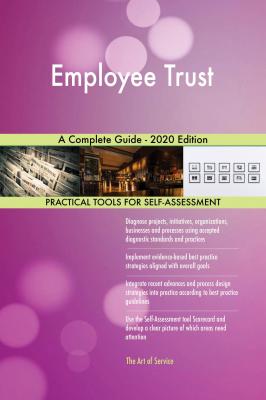Employee Trust A Complete Guide - 2020 Edition. Gerardus Blokdyk
Читать онлайн.| Название | Employee Trust A Complete Guide - 2020 Edition |
|---|---|
| Автор произведения | Gerardus Blokdyk |
| Жанр | Зарубежная деловая литература |
| Серия | |
| Издательство | Зарубежная деловая литература |
| Год выпуска | 0 |
| isbn | 9781867460459 |
<--- Score
74. Is the work to date meeting requirements?
<--- Score
75. What Employee trust services do you require?
<--- Score
76. What key stakeholder process output measure(s) does Employee trust leverage and how?
<--- Score
77. Is there a critical path to deliver Employee trust results?
<--- Score
78. Is there a clear Employee trust case definition?
<--- Score
79. Is data collected and displayed to better understand customer(s) critical needs and requirements.
<--- Score
80. Do you have organizational privacy requirements?
<--- Score
81. How have you defined all Employee trust requirements first?
<--- Score
82. Is the Employee trust scope manageable?
<--- Score
83. What are the tasks and definitions?
<--- Score
84. How would you define Employee trust leadership?
<--- Score
85. What is the scope of the Employee trust work?
<--- Score
86. Has a team charter been developed and communicated?
<--- Score
87. Why are you doing Employee trust and what is the scope?
<--- Score
88. What sources do you use to gather information for a Employee trust study?
<--- Score
89. Will a Employee trust production readiness review be required?
<--- Score
90. Do you have a Employee trust success story or case study ready to tell and share?
<--- Score
91. In what way can you redefine the criteria of choice clients have in your category in your favor?
<--- Score
92. What is the context?
<--- Score
93. If substitutes have been appointed, have they been briefed on the Employee trust goals and received regular communications as to the progress to date?
<--- Score
94. What defines best in class?
<--- Score
95. Are approval levels defined for contracts and supplements to contracts?
<--- Score
96. Has a high-level ‘as is’ process map been completed, verified and validated?
<--- Score
97. Where can you gather more information?
<--- Score
98. Are roles and responsibilities formally defined?
<--- Score
99. Is scope creep really all bad news?
<--- Score
100. Has the direction changed at all during the course of Employee trust? If so, when did it change and why?
<--- Score
101. Is Employee trust linked to key stakeholder goals and objectives?
<--- Score
102. Are improvement team members fully trained on Employee trust?
<--- Score
103. What is the definition of Employee trust excellence?
<--- Score
104. What scope to assess?
<--- Score
105. Is special Employee trust user knowledge required?
<--- Score
106. Have the customer needs been translated into specific, measurable requirements? How?
<--- Score
107. When are meeting minutes sent out? Who is on the distribution list?
<--- Score
108. Does the scope remain the same?
<--- Score
109. How do you gather requirements?
<--- Score
110. What is the scope of the Employee trust effort?
<--- Score
111. Will team members perform Employee trust work when assigned and in a timely fashion?
<--- Score
112. How do you gather Employee trust requirements?
<--- Score
113. Who is gathering information?
<--- Score
114. How do you think the partners involved in Employee trust would have defined success?
<--- Score
115. Are different versions of process maps needed to account for the different types of inputs?
<--- Score
116. Is the current ‘as is’ process being followed? If not, what are the discrepancies?
<--- Score
117. Has everyone on the team, including the team leaders, been properly trained?
<--- Score
118. Who approved the Employee trust scope?
<--- Score
119. What is in scope?
<--- Score
120. Has/have the customer(s) been identified?
<--- Score
121. Do the problem and goal statements meet the SMART criteria (specific, measurable, attainable, relevant, and time-bound)?
<--- Score
122. Is the Employee trust scope complete and appropriately sized?
<--- Score
123. Is there a Employee trust management charter, including stakeholder case, problem and goal statements, scope, milestones, roles and responsibilities, communication plan?
<--- Score
124. Is the team adequately staffed with the desired cross-functionality? If not, what additional resources are available to the team?
<--- Score
125. What are the compelling stakeholder reasons for embarking on Employee trust?
<--- Score
126. Are there any constraints known that bear on the ability to perform Employee trust work? How is the team addressing them?
<--- Score
127. How does the Employee trust manager ensure against scope creep?
<--- Score
128. What is a worst-case scenario for losses?
<--- Score
129. How are consistent Employee trust definitions important?
<---
